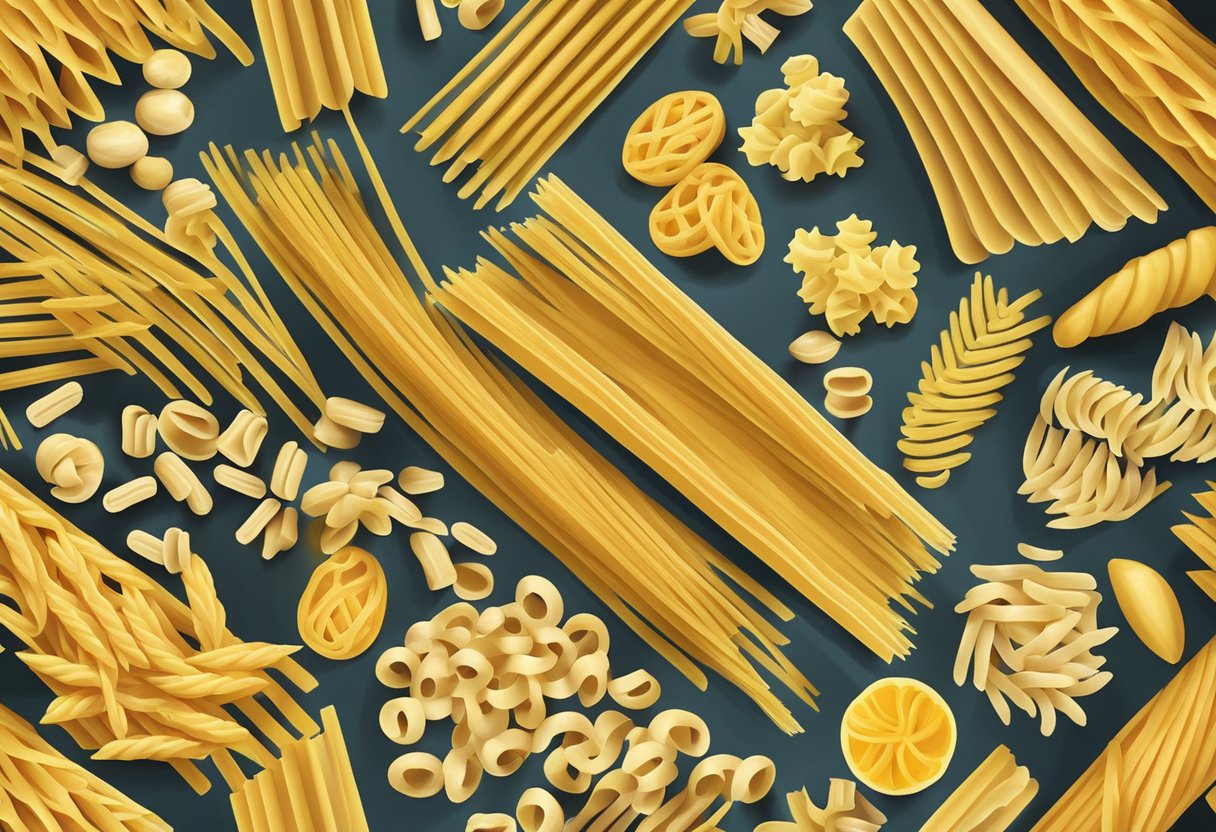Types Of Pasta Shapes
Pasta is a staple food in many households and is enjoyed worldwide. With over 600 different shapes and sizes, pasta is a versatile ingredient that can be used in many dishes. Each pasta shape has its own unique texture, taste, and cooking time, making it important to choose the right one for the recipe.
Pasta shapes can be categorized into long, short, stuffed, cooked in broth, stretched, or dumpling-like form. Each category has its own unique shapes and sizes. Long pasta shapes like spaghetti and linguine are perfect for dishes with light sauces, while short pasta shapes like fusilli and penne are ideal for thicker sauces. Stuffed pasta like ravioli and tortellini are great for dishes with fillings, and pasta cooked in broth like pastina is perfect for soups.
When it comes to pairing pasta with sauces, it is important to choose a shape that complements the sauce. For example, thicker sauces like rag√π are best paired with short pasta shapes like rigatoni and fusilli, while lighter sauces like pesto are best paired with long pasta shapes like linguine and spaghetti. It is also important to cook pasta al dente, which means it should be cooked until it is firm to the bite but not hard.
Key Takeaways
- Pasta comes in over 600 different shapes and sizes, each with its own unique texture, taste, and cooking time.
- Pasta shapes can be categorized into long, short, stuffed, cooked in broth, stretched, or dumpling-like form, each with its own unique shapes and sizes.
- When pairing pasta with sauces, it is important to choose a shape that complements the sauce, and to cook the pasta al dente.
Pasta Shape Categories

When it comes to pasta, there are many different shapes and sizes to choose from. Pasta can be divided into several categories based on their shape, including long pasta, short pasta, soup pasta, filled pasta, and specialty/regional pasta.
Long Pasta Shapes
Long pasta shapes are typically thin and cylindrical in shape. They are often made from durum wheat semolina and are perfect for dishes with light sauces. Some popular long pasta shapes include spaghetti, linguine, fettuccine, angel hair, and capellini. These pasta shapes are great for dishes such as carbonara, alfredo, and marinara sauces.
Short Pasta Shapes
Short pasta shapes are typically cut into small pieces and are often used in salads, soups, and casseroles. Some popular short pasta shapes include penne, macaroni, rigatoni, fusilli, rotini, ditalini, and orzo. These pasta shapes are great for dishes such as mac and cheese, pasta salads, and stews.
Soup Pasta Shapes
Soup pasta shapes are typically small and are often used in soups and stews. Some popular soup pasta shapes include pastina, orzo, and ditalini. These pasta shapes are great for dishes such as minestrone and other hearty soups.
Filled Pasta Shapes
Filled pasta shapes are typically stuffed with various fillings, such as cheese, meat, or vegetables. Some popular filled pasta shapes include ravioli, tortellini, cannelloni, and manicotti. These pasta shapes are great for dishes such as lasagna, baked ziti, and other baked pasta dishes.
Specialty and Regional Shapes
Specialty and regional pasta shapes vary widely depending on the region and culture. Some popular specialty and regional pasta shapes include orecchiette, pappardelle, gnocchi, trofie, and campanelle. These pasta shapes are great for dishes such as pesto pasta, ragu, and other regional pasta dishes.
Overall, the shape of pasta can greatly affect the texture and flavor of a dish. Whether you prefer long, short, soup, filled, or specialty pasta shapes, there is a pasta shape out there for everyone.
Pasta and Sauces Pairing
When it comes to pairing pasta shapes with sauces, there are a few general rules to follow. However, it’s important to remember that these are just guidelines and not strict rules. Ultimately, the pairing of pasta and sauce is a matter of personal preference.
Light Sauces
Lighter sauces are best paired with long, thin pasta shapes like angel hair pasta, spaghetti, and capellini. These pasta shapes are delicate and can be easily overwhelmed by heavier sauces. A simple tomato and basil sauce, or an aglio e olio (garlic and oil) sauce, are great options for these types of pasta.
Chunky and Meat Sauces
Chunky and meat sauces are best paired with larger, tube-shaped pasta shapes like rigatoni and penne pasta. The ridges and hollows of these pasta shapes help to hold onto the sauce, making each bite more flavorful. Vegetable sauces also work well with these pasta shapes. For example, a chunky tomato and vegetable sauce pairs nicely with penne pasta.
Creamy and Cheese Sauces
Creamy and cheese sauces are best paired with ribbon-shaped pasta like fettuccine and pappardelle. These pasta shapes are wider and more substantial, making them the perfect vehicle for rich, creamy sauces. Carbonara, macaroni and cheese, and Alfredo are all great options for these pasta shapes.
Oil-Based Sauces
Oil-based sauces are best paired with long, thin pasta shapes like spaghetti and linguine. These pasta shapes are coated evenly with the oil-based sauce, making each bite flavorful. Pancetta, seafood, and basil are great additions to oil-based sauces.
In summary, pairing pasta shapes with the right sauce can make a big difference in the overall taste and texture of the dish. By following these general guidelines, you can create delicious pasta dishes that are sure to please.
Cooking Techniques and Tips
Boiling and Al Dente
Boiling pasta is a relatively simple process, but there are a few tips to ensure that it comes out perfectly every time. Start by bringing a large pot of salted water to a rolling boil. For every pound of pasta, use at least 4 quarts of water and 1 tablespoon of salt. Once the water is boiling, add the pasta and stir occasionally to prevent it from sticking together.
One of the most important things to remember when cooking pasta is to cook it al dente, which means “to the tooth” in Italian. This term refers to pasta that is cooked until it is tender, but still has a slight bite to it. To achieve this, follow the cooking time on the package, but start testing the pasta a few minutes before the time is up. When the pasta is done, drain it immediately and rinse it with cold water to stop the cooking process.
Baking Pasta Dishes
Baking pasta dishes, such as lasagna, baked ziti, and macaroni and cheese, is a great way to create a hearty and comforting meal. When making these types of dishes, it’s important to start with a sturdy pasta shape, such as rigatoni, penne, or ziti, that can hold up to the sauce and cheese.
To prepare the pasta for baking, cook it until it is al dente, then drain it and rinse it with cold water. This will prevent the pasta from overcooking in the oven. Once the pasta is cooked, mix it with the sauce and any other ingredients, such as meat, vegetables, or cheese. Then, transfer the mixture to a baking dish and top it with more cheese, breadcrumbs, or other toppings.
When baking pasta dishes, it’s important to cover them with foil for the first half of the cooking time to prevent the cheese from burning. Then, remove the foil and continue baking until the cheese is melted and bubbly. Let the dish rest for a few minutes before serving to allow the flavors to meld together.
Whether using traditional dried pasta or making fresh pasta dough, pasta is a versatile and protein-packed addition to any diet. With these techniques and tips, anyone can create delicious and satisfying pasta dishes, from classic macaroni salad to cheesy baked casseroles.
Selecting and Storing Pasta
When it comes to selecting and storing pasta, there are a few things to consider. The type of pasta, whether it is fresh or dried, and how it is stored can all impact its shelf life and flavor.
Fresh vs Dried Pasta
Fresh pasta is made from a mixture of flour and eggs, while dried pasta is made from durum wheat semolina and water. Fresh pasta has a softer texture and a shorter shelf life than dried pasta. However, it can be more flavorful and is a great option for dishes like lasagna or stuffed pasta.
Dried pasta, on the other hand, has a longer shelf life and can be stored for months in a cool, dry place. It is also a great option for pasta dishes that require a firmer texture, like spaghetti or linguine.
Storing for Freshness
Regardless of whether you are storing fresh or dried pasta, it is important to keep it in a cool, dry place. Exposure to moisture or heat can cause the pasta to spoil or become stale.
Fresh pasta should be stored in the refrigerator and used within a few days. It can also be frozen for up to a month. Dried pasta should be stored in an airtight container and can be kept in the pantry for several months.
To ensure the best flavor and texture, it is recommended to use pasta within its recommended shelf life. Check the package for specific storage instructions and expiration dates. If you are unsure whether pasta is still fresh, give it a quick sniff. If it smells rancid or off, it is best to discard it.
Pasta in Diet and Nutrition
Pasta in a Balanced Diet
Pasta is a staple food in many cultures and is a good source of carbohydrates, which are essential for energy. It is also a good source of protein, fiber, vitamins, and minerals. However, it is important to consume pasta in moderation as it can be high in calories.
When incorporating pasta into a balanced diet, it is important to choose whole grain pasta over refined pasta. Whole grain pasta contains more fiber and nutrients than refined pasta. Additionally, adding vegetables to pasta dishes can increase the nutrient content and make the dish more filling.
Gluten-Free and Alternative Pastas
For those who are gluten intolerant or wish to avoid gluten, there are many alternative pasta options available. Gluten-free pasta is made from alternative grains such as rice, corn, and quinoa. These pastas can be just as nutritious as traditional pasta if they are made from whole grains.
Alternative pasta options such as zucchini noodles and spaghetti squash can also be used as a substitute for traditional pasta. These options are low in calories and carbohydrates and can be a good option for those looking to reduce their carbohydrate intake.
Overall, pasta can be a healthy addition to a balanced diet when consumed in moderation and with the right accompaniments. Choosing whole grain and alternative pasta options can increase the nutrient content of the dish and provide a variety of health benefits.






